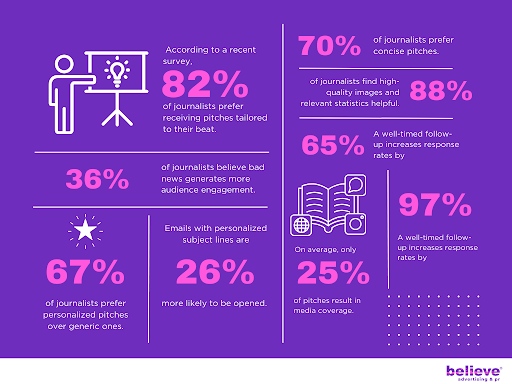Find out if you have what it takes to get international media coverage.
Best Practices for Pitching Your Story to Journalists

Best Practices for Pitching Your Story to Journalists
In the fast-paced realm of media, breaking through the noise and capturing a journalist’s attention requires a thoughtful and strategic approach. Leveraging data and insights, here’s a comprehensive guide on how to effectively contact journalists to pitch your stories, increasing your chances of media coverage.
1. Research Your Target Journalists:
Stat: According to a recent survey, 82% of journalists prefer receiving pitches tailored to their beat.
Before reaching out to journalists, extensive research is essential. Identify journalists who cover topics related to your story, aligning your pitch with their interests. This targeted approach significantly increases the likelihood of a positive response.
2. Craft a Compelling Story:
Stat: 36% of journalists believe bad news generates more audience engagement.
A captivating story is the cornerstone of a successful pitch. Craft a narrative that is not only timely and relevant but also aligns with the journalist’s beat. Highlighting the unique aspects of your story and emphasising its significance will make your pitch more compelling.
3. Personalise Your Pitch:
Stat: 67% of journalists prefer personalised pitches over generic ones.
Generic pitches often get overlooked. Personalise your outreach by addressing journalists by name and referencing their recent work. Demonstrating that your story aligns with their expertise and interests makes your pitch more appealing.
4. Write a Catchy Subject Line:
Stat: Emails with personalised subject lines are 26% more likely to be opened.
The subject line is your first impression. Craft a concise and intriguing subject line that encapsulates the essence of your story. Clarity and relevance are key to increasing the likelihood of your email being opened.
5. Keep it Concise:
Stat: 70% of journalists prefer concise pitches.
Journalists appreciate brevity. Keep your pitch brief and to the point, clearly articulating the main points of your story, its significance, and why it matters to their audience.
6. Provide Supporting Materials:
Stat: 88% of journalists find high-quality images and relevant statistics helpful.
Make the journalist’s job easier by providing supporting materials along with your pitch. Include visuals, statistics, and additional resources that enhance the story.
7. Follow Up Professionally:
Stat: A well-timed follow-up increases response rates by 65%.
After sending your initial pitch, a polite follow-up can reignite interest. Be respectful of their time and reiterate the key points of your story.
8. Leverage Social Media:
Stat: 97% of journalists use social media professionally.
Engage with journalists on platforms like Twitter or LinkedIn. Share their work, comment on articles, or send brief, respectful messages. A positive online presence can make your pitch more recognizable.
9. Be Prepared for Rejection:
Stat: On average, only 25% of pitches result in media coverage.
Not every pitch will lead to coverage, and that’s normal. Use any feedback received to refine your approach for future pitches.
Combining strategic insights with personalised and concise communication can significantly boost your chances of getting your story covered in the media. Remember, persistence and professionalism are crucial when navigating the competitive landscape of media outreach.
